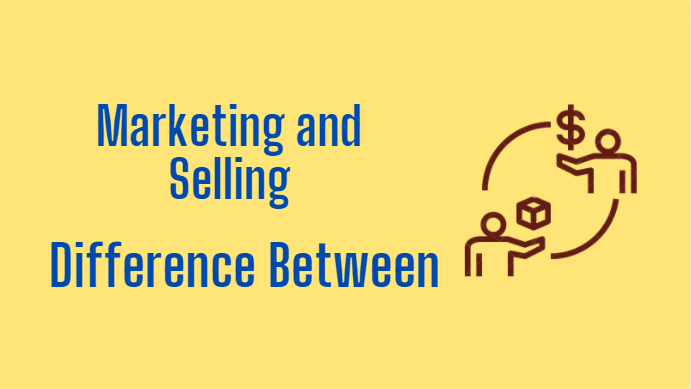Marketing Vs Selling: Key Differences & Examples Explained. In the realm of business, the terms “marketing” and “selling” are often used interchangeably, but they represent distinct concepts that play crucial roles in the success of any organization.
Understanding the differences between marketing and selling is essential for developing effective strategies that drive business growth. This ultimate guide will explore the nuances of both concepts, highlighting their unique characteristics, objectives, and methodologies.
Additionally, we will provide a detailed comparison table to clarify the distinctions and offer insights into how businesses can leverage both marketing and selling to achieve their goals.
What is Difference Between Marketing and Selling?
Marketing encompasses a broad range of activities aimed at promoting and selling products or services. It involves researching, promoting, and delivering value to customers while focusing on their needs and preferences.
The primary goal of marketing is to create awareness, generate interest, and build relationships with potential customers. Key components of marketing include:
- Market Research: Understanding consumer behavior, preferences, and trends to inform product development and marketing strategies.
- Branding: Establishing a strong brand identity that resonates with the target audience and differentiates the business from competitors.
- Advertising: Creating and disseminating promotional messages through various channels, such as social media, print, and digital platforms.
- Public Relations: Managing the public image of the company and building relationships with stakeholders, including customers, investors, and the media.
What is Selling?
Selling, on the other hand, refers specifically to the process of persuading a customer to purchase a product or service. It is a transactional activity that focuses on closing deals and generating revenue. The selling process typically involves direct interaction with potential customers and often includes negotiation and relationship-building. Key aspects of selling include:
- Sales Techniques: Utilizing various strategies to engage customers, address their concerns, and persuade them to make a purchase.
- Customer Interaction: Engaging with customers through face-to-face meetings, phone calls, or online chats to understand their needs and present solutions.
- Closing Deals: Finalizing the sale by overcoming objections, negotiating terms, and securing payment.
Key Differences Between Marketing and Selling.
To better understand the distinctions between marketing and selling, we can explore various parameters that highlight their differences. The following table summarizes these key differences:
| Aspect | Marketing | Selling |
|---|---|---|
| Objective | Create demand and customer satisfaction | Maximize sales and revenue |
| Focus | Customer needs and preferences | Product features and benefits |
| Approach | Strategic and long-term | Tactical and short-term |
| Nature | Process of identifying needs | Transaction-oriented |
| Techniques | Market research, advertising, public relations | Aggressive sales tactics, promotions |
| Time Orientation | Long-term focus | Short-term focus |
| Consumer Role | Active participant in decision-making | Passive audience |
| Seller’s Role | Facilitator of solutions | Decision-maker for transactions |
Detailed Comparison of Marketing and Selling.
1. Objective.
- Marketing: The primary objective of marketing is to create demand and build customer satisfaction. Marketing aims to develop a strong brand presence and foster long-term relationships with customers.
- Selling: The main objective of selling is to maximize sales and revenue. Selling focuses on persuading customers to make immediate purchases.
2. Focus.
- Marketing: Marketing emphasizes understanding customer needs and preferences. It seeks to create value for customers by addressing their pain points and desires.
- Selling: Selling focuses on the features and benefits of the product. It aims to convince customers of the product’s value and how it meets their needs.
3. Approach.
- Marketing: Marketing takes a strategic and long-term approach. It involves planning and executing campaigns that build brand awareness and customer loyalty over time.
- Selling: Selling is tactical and often short-term. It involves direct interactions with customers to close deals quickly.
4. Nature.
- Marketing: Marketing is a process of identifying and addressing customer needs. It encompasses various activities that contribute to creating a positive customer experience.
- Selling: Selling is transaction-oriented, focusing on the exchange of goods or services for money.
5. Techniques.
- Marketing: Techniques include market research, advertising, public relations, and content marketing. These methods aim to attract and engage potential customers.
- Selling: Techniques involve aggressive sales tactics, promotions, and personal selling. The focus is on persuading customers to buy.
6. Time Orientation.
- Marketing: Marketing has a long-term focus, aiming to build brand equity and customer loyalty over time.
- Selling: Selling has a short-term focus, concentrating on immediate sales and revenue generation.
7. Consumer Role.
- Marketing: Consumers are active participants in the decision-making process. They engage with marketing messages and provide feedback that shapes future marketing strategies.
- Selling: Consumers are often passive audiences during the selling process, primarily responding to sales pitches and promotions.
8. Seller’s Role.
- Marketing: The seller’s role in marketing is to facilitate solutions and provide value to customers. Marketing professionals aim to understand customer needs and create offerings that meet those needs.
- Selling: The seller’s role in selling is to be the decision-maker for transactions. Sales professionals focus on closing deals and achieving sales targets.
How to Effectively Integrate Marketing and Selling.
To maximize business success, it is essential to integrate marketing and selling strategies. Here are some effective ways to achieve this integration:
1. Align Goals and Objectives.
Ensure that both marketing and sales teams have aligned goals and objectives. This alignment fosters collaboration and ensures that both teams work towards common business outcomes.
2. Share Information.
Encourage open communication between marketing and sales teams. Sharing insights about customer behavior, preferences, and feedback can help both teams tailor their strategies for better results.
3. Develop Joint Campaigns.
Create joint marketing and sales campaigns that leverage the strengths of both functions. For example, marketing can generate leads through targeted campaigns, while sales can follow up with personalized outreach to convert those leads into customers.
4. Use Technology.
Utilize customer relationship management (CRM) systems to track customer interactions and data. This technology can help both marketing and sales teams access valuable information that informs their strategies.
5. Provide Training.
Offer training programs that educate both marketing and sales teams about each other’s roles and processes. Understanding how each function operates can lead to better collaboration and improved results.
Best Degrees for Careers in Marketing and Selling.
Pursuing a degree in business, marketing, or a related field can provide a strong foundation for a career in marketing or selling. Here are some of the best degrees to consider:
1. Bachelor’s Degree in Marketing.
A degree in marketing equips students with the skills needed to understand consumer behavior, develop marketing strategies, and manage branding efforts. This degree is ideal for those looking to pursue careers in marketing management, advertising, and market research.
2. Bachelor’s Degree in Business Administration.
A business administration degree provides a comprehensive understanding of various business functions, including marketing and sales. This degree is versatile and prepares graduates for a wide range of roles in the business world.
3. Bachelor’s Degree in Sales Management.
This specialized degree focuses on the principles of sales, including sales techniques, customer relationship management, and sales strategy development. Graduates are well-prepared for careers in sales management and business development.
4. Bachelor’s Degree in Communications.
A communications degree emphasizes effective communication skills, which are essential for both marketing and selling. Graduates can pursue careers in public relations, advertising, and corporate communications.
5. Master of Business Administration (MBA)
An MBA with a concentration in marketing or sales provides advanced knowledge and skills for leadership roles in marketing and sales. This degree is highly regarded and can open doors to executive positions.
Conclusion.
Understanding the difference between marketing and selling is crucial for any business aiming to succeed in today’s competitive landscape.
While both functions are interconnected and share the common goal of driving sales, they have distinct objectives, approaches, and roles in the business process.
By recognizing these differences and integrating marketing and selling strategies, businesses can create a cohesive and effective approach to reaching and satisfying customers.
Whether pursuing a career in marketing or selling, obtaining the right education and developing essential skills will be key to achieving success in these fields.
With the right strategies and a clear understanding of both marketing and selling, businesses can thrive and build lasting relationships with their customers.
Recommended Resources on ibusinessmotivation.com: To further your research, check out my guide on Best CRM Software Best Email Marketing Software, and the Best Invoice Factoring Software to try this year.








Like!! Great article post. Really thank you! Really Cool.
Thank you so much